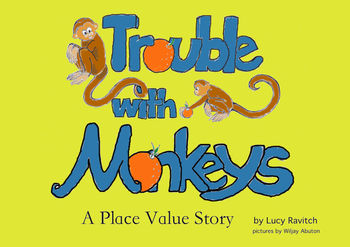Trouble with Monkeys: A place value story 32 page math concept picture book
Kids Math Teacher
173 Followers
Grade Levels
1st - 4th
Subjects
Resource Type
Standards
CCSS1.NBT.B.2
CCSS1.NBT.B.2a
CCSS1.NBT.B.2c
CCSS1.NBT.C.5
CCSS1.NBT.C.6
Formats Included
- PDF
Pages
34 pages
Kids Math Teacher
173 Followers
Description
This version is for letter size paper (8.5 x 11 inches) A4 paper version here. You can also see a video of the reading here.
Trouble with Monkeys: A place value story is a 32 page math concept picture book first intended for traditional publication. It teaches and reinforces the place value system from the ones place to the millions place. It underwent a major revision but I still thought this version had merit, so I am selling it here (it is all black and white).
Trouble with Monkeys is a story about a boy who tries to pack oranges at his Dad's packing house while his Dad's away, but mischievous monkeys have escaped from the zoo and got there first. The young boy is able to get obscure helpers from around the city and the oranges go from single oranges, into bags, into boxes, onto pallets, into trucks, onto trains, and eventually sail away on a cargo ship with one million oranges. Who knew a group of monkeys could be so much trouble while packing oranges?
It is appropriate for a wide span of ages (4-11), but is mainly geared towards 2nd, 3rd, and 4th graders. It not only reviews the place value system of ones through the millions, but it shows the progression of how the size gets bigger (in a way that children might be more familiar with).
It goes well with the Montessori golden beads teaching technique.
I hope you enjoy this story and find it helpful as you teach and reinforce the place value system with your students!
Trouble with Monkeys: A place value story is a 32 page math concept picture book first intended for traditional publication. It teaches and reinforces the place value system from the ones place to the millions place. It underwent a major revision but I still thought this version had merit, so I am selling it here (it is all black and white).
Trouble with Monkeys is a story about a boy who tries to pack oranges at his Dad's packing house while his Dad's away, but mischievous monkeys have escaped from the zoo and got there first. The young boy is able to get obscure helpers from around the city and the oranges go from single oranges, into bags, into boxes, onto pallets, into trucks, onto trains, and eventually sail away on a cargo ship with one million oranges. Who knew a group of monkeys could be so much trouble while packing oranges?
It is appropriate for a wide span of ages (4-11), but is mainly geared towards 2nd, 3rd, and 4th graders. It not only reviews the place value system of ones through the millions, but it shows the progression of how the size gets bigger (in a way that children might be more familiar with).
It goes well with the Montessori golden beads teaching technique.
I hope you enjoy this story and find it helpful as you teach and reinforce the place value system with your students!
Total Pages
34 pages
Answer Key
N/A
Teaching Duration
30 minutes
Report this resource to TPT
Reported resources will be reviewed by our team. Report this resource to let us know if this resource violates TPT’s content guidelines.
Standards
to see state-specific standards (only available in the US).
CCSS1.NBT.B.2
Understand that the two digits of a two-digit number represent amounts of tens and ones. Understand the following as special cases:
CCSS1.NBT.B.2a
10 can be thought of as a bundle of ten ones - called a “ten.”
CCSS1.NBT.B.2c
The numbers 10, 20, 30, 40, 50, 60, 70, 80, 90 refer to one, two, three, four, five, six, seven, eight, or nine tens (and 0 ones).
CCSS1.NBT.C.5
Given a two-digit number, mentally find 10 more or 10 less than the number, without having to count; explain the reasoning used.
CCSS1.NBT.C.6
Subtract multiples of 10 in the range 10-90 from multiples of 10 in the range 10-90 (positive or zero differences), using concrete models or drawings and strategies based on place value, properties of operations, and/or the relationship between addition and subtraction; relate the strategy to a written method and explain the reasoning used.





